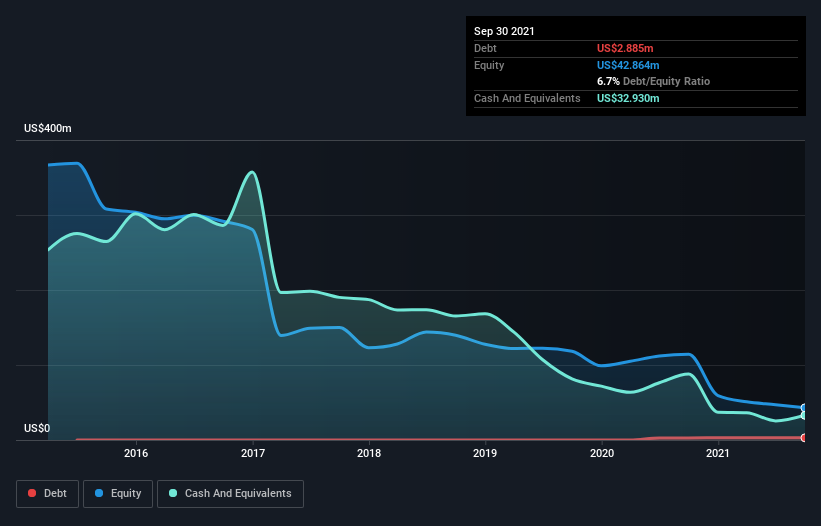Some say volatility, rather than debt, is the best way to think about risk as an investor, but Warren Buffett famously said that 'Volatility is far from synonymous with risk.' So it seems the smart money knows that debt - which is usually involved in bankruptcies - is a very important factor, when you assess how risky a company is. Importantly, Zovio Inc (NASDAQ:ZVO) does carry debt. But the real question is whether this debt is making the company risky.
Why Does Debt Bring Risk?
Debt and other liabilities become risky for a business when it cannot easily fulfill those obligations, either with free cash flow or by raising capital at an attractive price. In the worst case scenario, a company can go bankrupt if it cannot pay its creditors. However, a more usual (but still expensive) situation is where a company must dilute shareholders at a cheap share price simply to get debt under control. Of course, debt can be an important tool in businesses, particularly capital heavy businesses. When we examine debt levels, we first consider both cash and debt levels, together.
Check out our latest analysis for Zovio
What Is Zovio's Net Debt?
You can click the graphic below for the historical numbers, but it shows that as of September 2021 Zovio had US$2.89m of debt, an increase on US$2.76m, over one year. But on the other hand it also has US$32.9m in cash, leading to a US$30.0m net cash position.

How Strong Is Zovio's Balance Sheet?
According to the last reported balance sheet, Zovio had liabilities of US$71.0m due within 12 months, and liabilities of US$44.0m due beyond 12 months. Offsetting this, it had US$32.9m in cash and US$9.02m in receivables that were due within 12 months. So its liabilities outweigh the sum of its cash and (near-term) receivables by US$73.0m.
The deficiency here weighs heavily on the US$36.8m company itself, as if a child were struggling under the weight of an enormous back-pack full of books, his sports gear, and a trumpet. So we'd watch its balance sheet closely, without a doubt. At the end of the day, Zovio would probably need a major re-capitalization if its creditors were to demand repayment. Zovio boasts net cash, so it's fair to say it does not have a heavy debt load, even if it does have very significant liabilities, in total. There's no doubt that we learn most about debt from the balance sheet. But you can't view debt in total isolation; since Zovio will need earnings to service that debt. So when considering debt, it's definitely worth looking at the earnings trend. Click here for an interactive snapshot.
Over 12 months, Zovio made a loss at the EBIT level, and saw its revenue drop to US$301m, which is a fall of 25%. That makes us nervous, to say the least.
So How Risky Is Zovio?
By their very nature companies that are losing money are more risky than those with a long history of profitability. And the fact is that over the last twelve months Zovio lost money at the earnings before interest and tax (EBIT) line. Indeed, in that time it burnt through US$8.7m of cash and made a loss of US$76m. With only US$30.0m on the balance sheet, it would appear that its going to need to raise capital again soon. Overall, we'd say the stock is a bit risky, and we're usually very cautious until we see positive free cash flow. When analysing debt levels, the balance sheet is the obvious place to start. But ultimately, every company can contain risks that exist outside of the balance sheet. These risks can be hard to spot. Every company has them, and we've spotted 5 warning signs for Zovio (of which 2 are a bit unpleasant!) you should know about.
If you're interested in investing in businesses that can grow profits without the burden of debt, then check out this free list of growing businesses that have net cash on the balance sheet.
Valuation is complex, but we're here to simplify it.
Discover if Zovio might be undervalued or overvalued with our detailed analysis, featuring fair value estimates, potential risks, dividends, insider trades, and its financial condition.
Access Free AnalysisHave feedback on this article? Concerned about the content? Get in touch with us directly. Alternatively, email editorial-team (at) simplywallst.com.
This article by Simply Wall St is general in nature. We provide commentary based on historical data and analyst forecasts only using an unbiased methodology and our articles are not intended to be financial advice. It does not constitute a recommendation to buy or sell any stock, and does not take account of your objectives, or your financial situation. We aim to bring you long-term focused analysis driven by fundamental data. Note that our analysis may not factor in the latest price-sensitive company announcements or qualitative material. Simply Wall St has no position in any stocks mentioned.
About OTCPK:ZVOI
Zovio
Operates as an education technology services company in the United States.
Slight risk with weak fundamentals.
Similar Companies
Market Insights
Community Narratives



